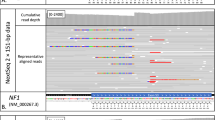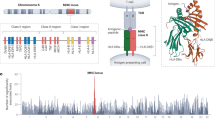Abstract
Completion of the Human Genome Project1 and the HapMap Project2 has led to increasing demands for mapping complex traits in humans to understand the aetiology of diseases3. Identifying variations in the DNA sequence, which affect how we develop disease and respond to pathogens and drugs, is important for this purpose, but it is difficult to identify these variations in large sample sets3,4,5. Here we show that through a combination of capillary sequencing and polymerase chain reaction assisted by gold nanoparticles, it is possible to identify several DNA variations that are associated with age-related macular degeneration6,7,8 and psoriasis9 on significant regions of human genomic DNA. Our method is accurate and promising for large-scale and high-throughput genetic analysis of susceptibility towards disease and drug resistance10,11,12.
This is a preview of subscription content, access via your institution
Access options
Subscribe to this journal
Receive 12 print issues and online access
$259.00 per year
only $21.58 per issue
Buy this article
- Purchase on Springer Link
- Instant access to full article PDF
Prices may be subject to local taxes which are calculated during checkout




Similar content being viewed by others
References
McPherson, J. D. et al. A physical map of the human genome. Nature 409, 934–941 (2001).
Frazer, K. A. & Consortium, T. I. H. A second generation human haplotype map of over 3.1 million SNPs. Nature 449, 851–861 (2007).
Douglas, J. A., Boehnke, M., Gillanders, E., Trent, J. M. & Gruber, S. B. Experimentally-derived haplotypes substantially increase the efficiency of linkage disequilibrium studies. Nature Genet. 28, 361–364 (2001).
Xiao, M. et al. Direct determination of haplotypes from single DNA molecules. Nature Methods 6, 199–201 (2009).
Kwok, P. Y. & Xiao, M. Single-molecule analysis for molecular haplotyping. Hum. Mutat. 23, 442–446 (2004).
DeWan, A. et al. HTRA1 promoter polymorphism in wet age-related macular degeneration. Science 314, 989–992 (2006).
Fritsche, L. G. et al. Age-related macular degeneration is associated with an unstable ARMS2 (LOC387715) mRNA. Nature Genet. 40, 892–896 (2008).
Kanda, A. et al. A variant of mitochondrial protein LOC387715/ARMS2, not HTRA1, is strongly associated with age-related macular degeneration. Proc. Natl Acad. Sci. USA 104, 16227–16232 (2007).
Zhang, X. J. et al. Psoriasis genome-wide association study identifies susceptibility variants within LCE gene cluster at 1q21. Nature Genet. 41, 205–210 (2009).
Collins, F. S., Guyer, M. S. & Chakravarti, A. Variations on a theme: cataloging human DNA sequence variation. Science 278, 1580–1581 (1997).
Folstein, S. & Rutter, M. Genetic influences and infantile autism. Nature 265, 726–728 (1977).
Collins, F. S., Brooks, L. D. & Chakravarti, A. A DNA polymorphism discovery resource for research on human genetic variation. Genome Res. 8, 1229–1231 (1998).
Kwok, P. Y. Methods for genotyping single nucleotide polymorphisms. Annu. Rev. Genom. Hum. Genet. 2, 235–258 (2001).
Beaudet, A. L. & Belmont, J. W. Array-based DNA diagnostics: let the revolution begin. Ann. Rev. Med. 59, 113–129 (2008).
Rosi, N. L. & Mirkin, C. A. Nanostructures in biodiagnostics. Chem. Rev. 105, 1547–1562 (2005).
Lu, Y. & Liu, J. Smart nanomaterials inspired by biology: dynamic assembly of error-free nanomaterials in response to multiple chemical stimuli. Acc. Chem. Res. 40, 315–323 (2007).
Li, H. et al. Nanoparticle PCR: nanogold-assisted PCR with enhanced specificity. Angew. Chem. Int. Ed. 44, 5100–5103 (2005).
Li, M., Lin, Y. C., Wu, C. C. & Liu, H. S. Enhancing the efficiency of a PCR using gold nanoparticles. Nucleic Acids Res. 33, e184 (2005).
Mi, L. et al. Modulation of DNA polymerases with gold nanoparticles and their applications in hot-start PCR. Small 5, 2597–2600 (2009).
Rosi, N. L. et al. Smart nanomaterials inspired by biology: dynamic assembly of error-free nanomaterials in response to multiple chemical stimuli. Science 312, 1027–1030 (2006).
Li, H. & Rothberg, L. Colorimetric detection of DNA sequences based on electrostatic interactions with unmodified gold nanoparticles. Proc. Natl Acad. Sci. USA 101, 14036–14039 (2004).
Sharma, J. et al. Control of self-assembly of DNA tubules through integration of gold nanoparticles. Science 323, 112–116 (2009).
Herdt, A. R., Drawz, S. M., Kang, Y. & Taton, T. A. DNA dissociation and degradation at gold nanoparticle surfaces. Colloid. Surface. B 51, 130–139 (2006).
Tost, J. et al. Molecular haplotyping at high throughput. Nucleic Acids Res. 30, e96 (2002).
Voelkerding, K. V., Dames, S. & Durtschi, J. D. Next generation sequencing for clinical diagnostics-principles and application to targeted resequencing for hypertrophic cardiomyopathy. J. Mol. Diag. 12, 539–551 (2010).
Shendure, J. & Ji, H. Next-generation DNA sequencing. Nature Biotechnol. 26, 1146–1153 (2008).
Stephens, M., Smith, N. J. & Donnelly, P. A new statistical method for haplotype reconstruction from population data. Am. J. Hum. Genet. 68, 978–989 (2001).
Levenstien, M. A., Ott, J. & Gordon, D. Are molecular haplotypes worth the time and expense? A cost-effective method for applying molecular haplotypes. PLOS Genet. 2, e127 (2006).
Fan, H. C., Wang, J., Potanina, A. & Quake, S. R. Whole-genome molecular haplotyping of single cells. Nature Biotechnol. 29, 51–57 (2010).
Kitzman, J. O. et al. Haplotype-resolved genome sequencing of a Gujarati Indian individual. Nature Biotechnol. 29, 59–63 (2010).
Acknowledgements
This work was supported by the National 863 Program (2009AA022701), the National 973 Program (2010CB529602, 2007CB936000, 2012CB932600), the Natural Science Foundation of China (20725516, 31000553, 90913014, 20902096), the Foundation for the Author of National Excellent Doctoral Dissertation of PR China (201026), the Program for New Century Excellent Talents in University (NCET-09-0550), the Shanghai Changning Health Bureau Program (2008406002), the Shanghai Municipal Health Bureau Program (2008095), the Shanghai Leading Academic Discipline Project (B205), CAS (KJCX2-EW-N03) and the Major S&T Program (2009ZX10004-301).
Author information
Authors and Affiliations
Contributions
Y.S. and C.F. conceived and designed the experiments. P.C., D.P., J.C., D.W. and H.Z. performed the experiments. J.C. and P.C. analysed the data. K.H., Y.L., P.L. and L.H. contributed materials/analysis tools. Y.S. and G.F. collected DNA samples. P.C., D.P., C.F. and Y.S. co-wrote the paper. P.C. and D.P. contributed equally to this work. All authors discussed the results and commented on the manuscript.
Corresponding authors
Ethics declarations
Competing interests
The authors declare no competing financial interests.
Supplementary information
Supplementary information
Supplementary information (PDF 705 kb)
Rights and permissions
About this article
Cite this article
Chen, P., Pan, D., Fan, C. et al. Gold nanoparticles for high-throughput genotyping of long-range haplotypes. Nature Nanotech 6, 639–644 (2011). https://doi.org/10.1038/nnano.2011.141
Received:
Accepted:
Published:
Issue Date:
DOI: https://doi.org/10.1038/nnano.2011.141
This article is cited by
-
Effects of graphene oxide on PCR amplification for microbial community survey
BMC Microbiology (2020)
-
Development of gold nanoparticles biosensor for ultrasensitive diagnosis of foot and mouth disease virus
Journal of Nanobiotechnology (2018)
-
Programming DNA origami assembly for shape-resolved nanomechanical imaging labels
Nature Protocols (2018)
-
Real-time label-free analysis of the thermostability of DNA structures using GelRed
Nuclear Science and Techniques (2018)
-
Protein-mimicking nanoparticle (Protmin)-based nanosensor for intracellular analysis of metal ions
Nuclear Science and Techniques (2018)



